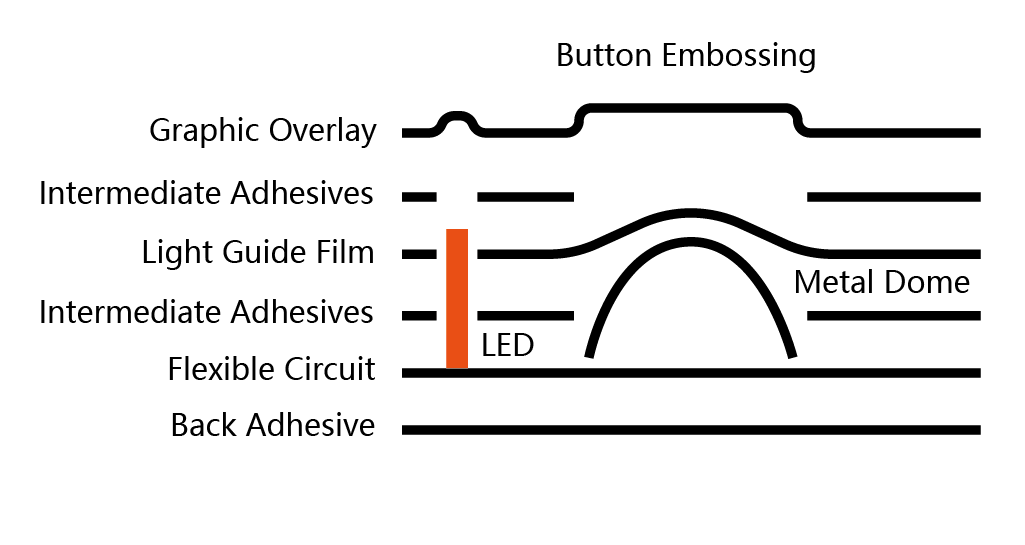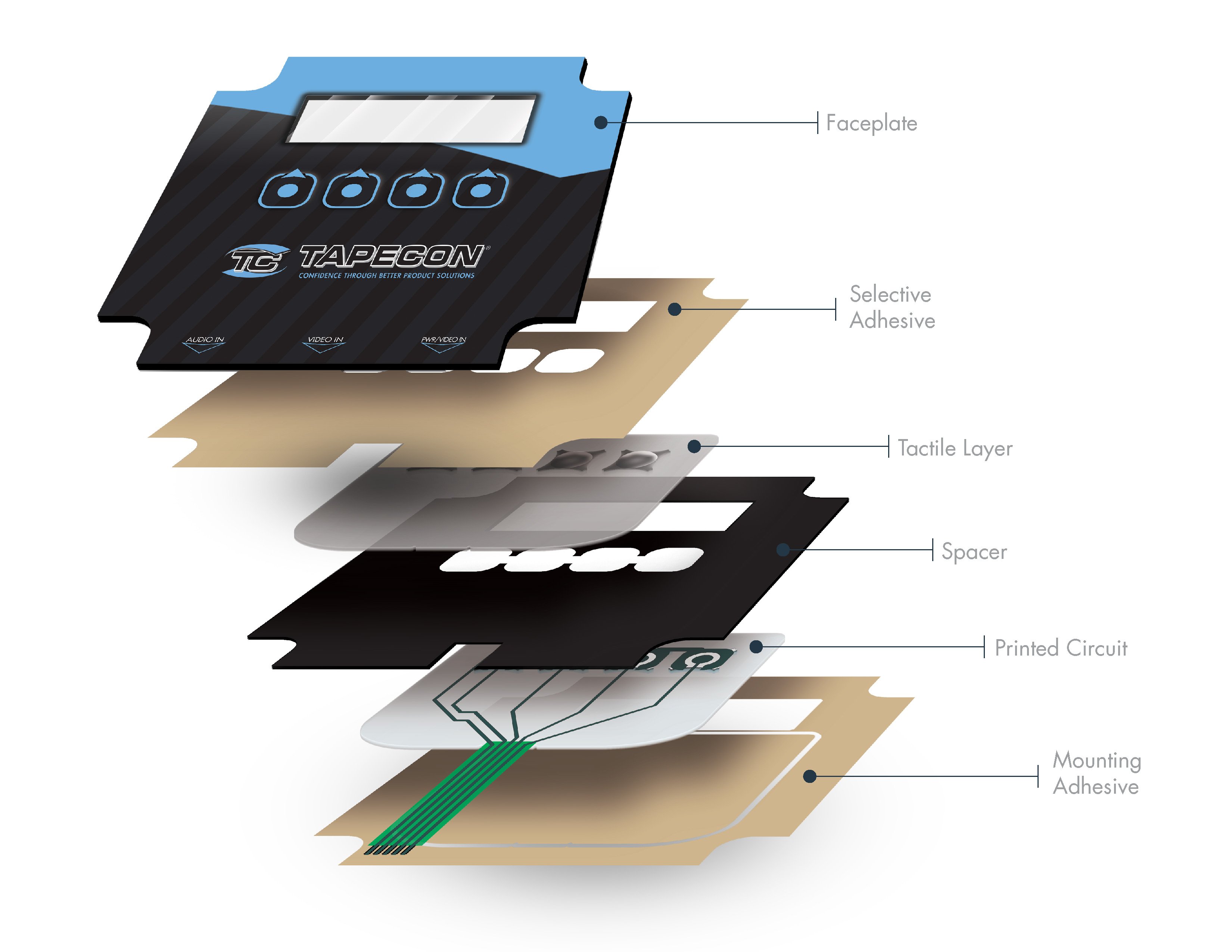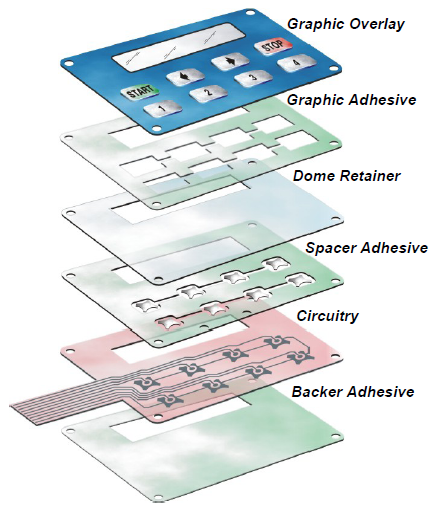The Manufacturing Process Behind Membrane Switch: What You Required to Know
The production procedure behind membrane layer switches over combines mindful design, material option, and high quality control. It starts with understanding the complexities of membrane layer button layout and proceeds via different phases, including material choices and printing strategies. Each stage plays a necessary function in making sure capability and longevity. However, the complexities of layer building and construction and the extensive screening requirements might expose understandings that are not immediately apparent. What exists past these foundational components?
Recognizing Membrane Layer Switch Style
Membrane layer switches might show up easy at initial glance, their layout includes detailed considerations that ensure performance and toughness. The style procedure starts with a comprehensive understanding of customer requirements, including the user interface's intended application and ecological factors. Ergonomics is a crucial element, as the format must promote simplicity of use while ensuring that tactile feedback meets individual expectations.Moreover, the layering of elements, such as visuals overlays, sticky layers, and conductive traces, need to be specifically engineered. membrane switch. This layered configuration not only affects the switch's responsiveness however also influences its long life. Focus is offered to the sealing techniques employed to secure versus dampness and dirt, which might compromise efficiency. Additionally, layout factors to consider extend to visual appeals, where color plans and visual clarity improve customer experience. Ultimately, the style of membrane changes balances capability, customer experience, and longevity, guaranteeing that they meet the demands of different applications efficiently
Materials Made Use Of in Membrane Change Manufacturing
When picking materials for membrane switch manufacturing, it is important to contemplate both performance and resilience. The key products include polyester and polycarbonate movies, which give adaptability and strength. These movies are typically coated with glue to guarantee appropriate bonding to substratums. Conductive inks, normally made up of silver or carbon, are vital for producing electric connections within the switch, enabling dependable operation.Additionally, a safety layer, such as a difficult layer, is often put on boost scrape resistance and long life. The choice of backing product, such as acrylic or foam, can considerably impact the switch's responsive feeling and general user experience. Different environmental aspects, including temperature level and humidity, need to lead material choice to guarantee peak efficiency in details applications. Ultimately, the right combination of products contributes to the membrane switch's functionality and lifespan, making informed options necessary for suppliers.
The Printing Refine: Creating Graphics and Text
The printing process in membrane layer button manufacturing plays a substantial function in creating premium graphics and text. Various graphic style methods are employed to guarantee visual appeal and functionality, while mindful ink option methods are necessary for longevity and performance. Recognizing these aspects is basic for accomplishing ideal results in membrane layer switch style.
Graphic Style Techniques
Graphic style techniques play a crucial duty in the printing procedure of membrane layer switches, as they specify just how graphics and message will ultimately appear on the end product. Reliable visuals layout entails the calculated use font styles, shades, and designs to improve readability and visual charm. Designers typically use vector graphics for scalability, making sure that images continue to be sharp at various sizes. In addition, focus to contrast and placement is crucial, as it affects customer interaction and visual quality. The unification of branding components, such as logos, should be managed with like preserve brand stability. Overall, thoughtful visuals style strategies add substantially to the capability and good looks of membrane buttons, influencing individual experience and product efficiency.
Ink Selection Approaches
Selecting the proper ink is vital for accomplishing the desired visual quality and durability in membrane switch manufacturing. Numerous ink kinds are utilized, including solvent-based, water-based, and UV-curable inks. Each type provides unique qualities, such as bond, versatility, and resistance to environmental factors. Solvent-based inks are commonly preferred for their toughness and vivid shades, while water-based inks are a lot more eco-friendly however may have limitations in bond. UV-curable inks provide fast curing and robust efficiency. Furthermore, shade matching strategies assure that the chosen inks line up with layout specifications. Ultimately, the option of ink need to consider factors such as application technique, substratum compatibility, and end-use needs to achieve exceptional lead to membrane switch graphics and message.
Layer Building and Assembly

Material Option Process
A careful option of materials is crucial in the production process of membrane buttons, as it straight influences performance and resilience. The key products utilized consist of polyester, polycarbonate, and numerous conductive inks. Polyester is typically preferred for its excellent resistance to chemicals and abrasion, making it ideal for extreme settings. Polycarbonate, on the various other hand, gives premium clarity and influence resistance, which is useful for applications needing visibility and toughness. Conductive inks, usually composed of silver or carbon, are important for creating reputable electrical paths. Furthermore, the option of sticky products impacts the overall integrity of the switch - membrane switch. Evaluating elements such as environmental exposure, responsive responses, and visual requirements guides producers in choosing the ideal products for their details applications
Layer Bond Strategies
Adhering layers in membrane switch building is an important procedure that ensures functionality and longevity. Various attachment techniques are utilized to safeguard optimal bonding between layers, which typically consist of making use of adhesives, warm, and pressure. Pressure-sensitive adhesives (PSAs) are typically used for their convenience of application and prompt bonding abilities. Furthermore, thermal bonding strategies can be applied, where warmth is used to trigger sticky buildings, protecting a solid bond. The selection of bond approach largely depends on the products involved and the see particular application needs of the membrane button. Proper positioning and uniform application of adhesives are vital to stop flaws, securing the switch operates properly throughout its intended lifespan.
Quality Assurance Steps
Ensuring top quality control throughout the layer construction and setting up of membrane switches is necessary for preserving efficiency and dependability. This process generally involves numerous vital steps, consisting of complete assessments at each stage of production. Suppliers utilize innovative screening methods, such as peel examinations and bond assessments, to confirm the integrity of layer bonds. Furthermore, aesthetic inspections are conducted to recognize any defects in printing or material inconsistencies. Environmental conditions, such as temperature level and moisture, are carefully kept track of to guarantee excellent healing and bond. Regular calibration of tools helps maintain specific production requirements. By carrying out these high quality control steps, manufacturers can substantially minimize the danger of item failure, ensuring that the final membrane switches fulfill the needed specifications and client assumptions.
Checking and High Quality Control Actions

Advancements in Membrane Layer Switch Over Innovation
As improvements in modern technology proceed to develop, membrane layer buttons are gaining from cutting-edge advancements that boost their performance and customer experience. One significant technology is the integration of capacitive touch modern technology, which enables even more user-friendly and responsive individual interfaces. This change not just improves visual appeals yet likewise reduces mechanical wear and tear, extending the life-span of the switches.Additionally, innovations in visuals overlay products have actually brought about improved toughness and look at these guys resistance to environmental variables such as dampness and UV light. These products currently provide enhanced clarity and brightness, additional raising the visual appeal.Furthermore, the incorporation of wise innovation is transforming membrane layer changes right into interactive control board, allowing connection with IoT tools. This connection cultivates a seamless individual experience, leading the way for applications in various sectors, from health care to customer electronics. Collectively, these developments position membrane switches over as crucial elements in modern-day device style.
Often Asked Inquiries
The length of time Does the Membrane Layer Switch Over Manufacturing Process Take?
The duration of the membrane button manufacturing procedure can vary considerably. Variables such as complexity, materials utilized, and production volume impact timelines, with typical manufacturing ranging from a couple of days to numerous weeks for completion.
What Are the Common Applications for Membrane Buttons?
Membrane buttons are commonly made use of in different markets, including vehicle controls, house appliances, medical devices, and consumer electronics (membrane switch). Their flexibility and toughness make them suitable for applications calling for user-friendly other user interfaces and dependable efficiency in varied environments
Can Membrane Changes Be Custom-made for Particular Requirements?

What Is the Life-span of a Normal Membrane Change?
The lifespan of a normal membrane button varies, however usually, it ranges from 1 to 5 million cycles. Aspects such as usage, atmosphere, and material top quality substantially affect toughness and general performance in time.

Are Membrane Switches Eco Pleasant?
The environmental friendliness of membrane layer switches differs. Some products utilized might not be recyclable, while others can be environment-friendly. The overall impact depends on manufacturing materials and practices, demanding careful consideration throughout option and disposal. The production process behind membrane switches combines mindful style, product choice, and quality control. It starts with recognizing the complexities of membrane layer button design and progresses via numerous phases, consisting of product selections and printing strategies. When choosing materials for membrane button manufacturing, it is necessary to contemplate both performance and sturdiness. A mindful selection of materials is essential in the manufacturing procedure of membrane layer switches, as it straight influences functionality and resilience. The choice of adhesion technique mostly depends on the products involved and the particular application requirements of the membrane layer switch.
Comments on “Why membrane switch is helping modernize industrial workflows”